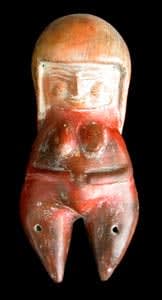Chorrera Terracotta Fertility Goddess, 1100 BCE - 300 CE
Terracotta
2.875 x 6.5
PF.2427
Further images
The Pre-Columbian cultures of Ecuador are among the oldest in South America and among the first to master the art of pottery. Although we know little about the peoples themselves...
The Pre-Columbian cultures of Ecuador are among the oldest in South America and among the first to master the art of pottery. Although we know little about the peoples themselves or their traditions, historians have been able to piece together a picture of life in Ancient Ecuador thanks in part to the art and artifacts left behind. The culture of Valdivia created some of the oldest known works of art in the Americas. Situated along the coastal strip of Ecuador, the Valdivians established a thriving society that flourished for around two thousand years (from approximately 4000 to 1500 B.C.). Today they are famed for their small fertility figures, believed to be the earliest representational works of art in the Americas, first carved from stone, later formed from terracotta.
Hundreds of years later after the Valdivians disappear from the archaeological record appears another culture to which the name Chorrera has been attached (lasting from circa 1100-300 B.C.). Little is known about this culture; however, it is significant for its widespread geographical reach. As such, their artistic style greatly influenced those diverse cultures that began to emerge in the final centuries of the Chorrera period, a time historians have labeled the Period of Regional Development.
Compelling in appearance, this pregnant mother Goddess is a beautiful example of Ancient Ecuadorian ceramic art. This mother Goddess image exemplifies the remarkable creative efforts of the Chorrera culture, for she expresses a host of Universal sensibilities that can be felt and understood by all who experience her. She stands before us on short conical-shaped legs with delicate arms resting across her swollen belly, which immediately focuses our rapt attention upon her fertile, womanliness. Large breasts and ample hips further accentuate her fecund female qualities while at the same time a distinctive face and hairdo distinguish her as a Chorrera artist's unique work of art. This ancient and powerful ceramic figure is truly a symbol of the primal mother Goddess, representing the abundance and stability of earth, the never-ending cycle of life, death and renewal. She evokes from within all who behold her wonderful, loving and well-nurtured feelings.
Hundreds of years later after the Valdivians disappear from the archaeological record appears another culture to which the name Chorrera has been attached (lasting from circa 1100-300 B.C.). Little is known about this culture; however, it is significant for its widespread geographical reach. As such, their artistic style greatly influenced those diverse cultures that began to emerge in the final centuries of the Chorrera period, a time historians have labeled the Period of Regional Development.
Compelling in appearance, this pregnant mother Goddess is a beautiful example of Ancient Ecuadorian ceramic art. This mother Goddess image exemplifies the remarkable creative efforts of the Chorrera culture, for she expresses a host of Universal sensibilities that can be felt and understood by all who experience her. She stands before us on short conical-shaped legs with delicate arms resting across her swollen belly, which immediately focuses our rapt attention upon her fertile, womanliness. Large breasts and ample hips further accentuate her fecund female qualities while at the same time a distinctive face and hairdo distinguish her as a Chorrera artist's unique work of art. This ancient and powerful ceramic figure is truly a symbol of the primal mother Goddess, representing the abundance and stability of earth, the never-ending cycle of life, death and renewal. She evokes from within all who behold her wonderful, loving and well-nurtured feelings.





